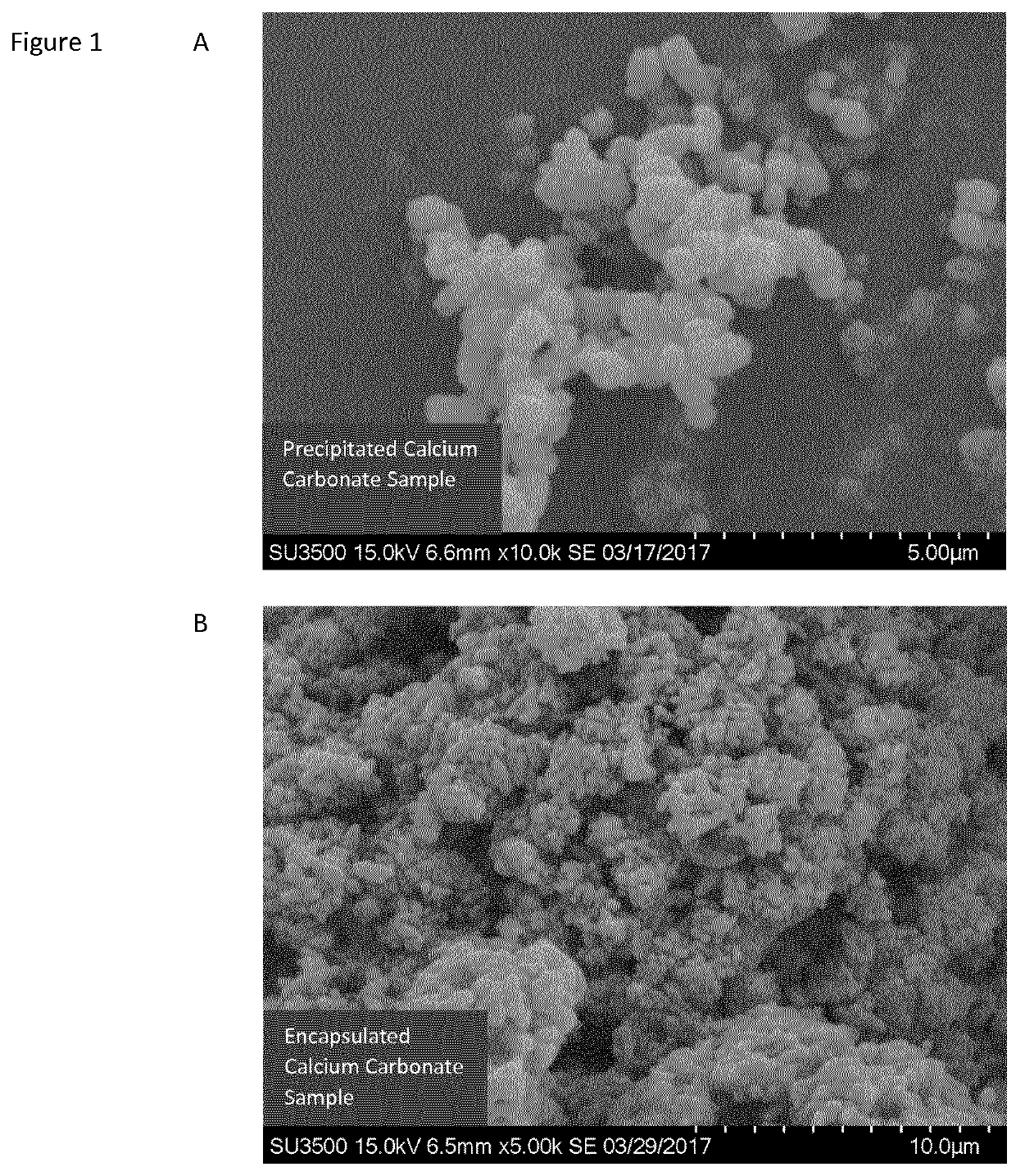Capsules with opacifier
- Summary
- Abstract
- Description
- Claims
- Application Information
AI Technical Summary
Benefits of technology
Problems solved by technology
Method used
Image
Examples
example 1
ing Formulation Design
[0122]CaCO3 was tested for its ability to induce opacity and for its effect on the mechanical strength of the polymeric films formed. This was tested on both cellulose-based (HPMC) and gelatin-based films.
[0123]A dispersion of non-encapsulated CaCO3 is first prepared and added to the film-forming formulation. The same general procedure is used for gelatin and HPMC formulations.
[0124]In short, 60 g of water was added to 22.45 g of precipitated CaCO3 (PCC) and the mixture was homogenized with high shear mixing (e.g. high shear mixing at 21000 rpm (Ultra Turax) for 3×2 minutes with 30 sec pause between each mixing).
[0125]Subsequently a part of (e.g. 20 g) of the liquid film-forming HPMC or gelatin formulation, comprising 20.5 wt % HPMC in water or 31 wt % gelatin in water is added and mixed into the dispersion under stirring at 12000 rpm (e.g. Silverson apparatus), during e.g. 3 minutes, thereby forming a slurry. Said slurry is then mixed with the remaining part o...
example 2
HPMC Films and Capsules
[0135]Next a study was done on the impact of different levels of calcium carbonate on the films and capsules properties.
[0136]For this, the same procedure as used for producing HPMC films according to example 1 was used, but with several calcium carbonate concentrations and types (PCC as in Table 1 or 2, or encapsulated CaCO3). The following protocol was used to prepare the 10 wt % CaCO3 in a 20.5 wt. % HPMC-based films:
Step 1HPMC solutionHPMC202.05gWater783.56g(cc of HPMC20.5wt %)Step 2Dispersion preparationCaCO322.45gWater60g(cc of CaCO3 (PCC)27.2wt %)Step 3Slurry preparationDispersion from Step 282.45gHPMC solution from Step 120gStep 4Final formulationPolymer solution965.61gslurry102.45gResult10 wt % CaCO3 on20.5 wt % HPMC capsule
[0137]In order to reach a film forming composition comprising 6.5 wt % of CaCO3 based on the final dry weight of said film-forming composition, step 4 of the above protocol is as follows:
Step 1HPMC solutionHPMC322.93gWater1252.36g(...
example 3
elatin Films
[0146]The film-forming composition and method from Example 1 was used to produce gelatin films.
Step 1gelatin solution (HGC melt preparation)gelatin322.94gWater718.79g(cc of gelatin31wt %)Step 2Dispersion preparationCaCO322.45gWater60g(cc of CaCO327.2wt %)Step 3Slurry preparationDispersion from Step 282.45ggelatin solution from Step 120gStep 4Coloring the formulationPolymer solution1021.71slurry 102.45Result6.5 wt % CaCO3 on30.1 wt % gelatin capsule
[0147]Opacity and light transmittance at 650 nm were tested as explained above and the results are outlined in Table 7 below. Comparable results are obtained for precipitated CaCO3 (PCC as in Table 1 or 2) and encapsulated CaCO3.
TABLE 7opacity and transmittance at 650 nm of gelatin-based films5%10%5%10%precip.precip.EncapsulatedEncapsulatedTransparent2% TiO2CaCO3CaCO3CaCO3CaCO3Opacity (%)15.8362.418.9623.8824.1532.1Transmittance at82.21.749.227.548.528.8650 nm (%)
[0148]Tensile tests on films were done as explained above for the...
PUM
| Property | Measurement | Unit |
|---|---|---|
| Volume | aaaaa | aaaaa |
| Volume | aaaaa | aaaaa |
| Volume | aaaaa | aaaaa |
Abstract
Description
Claims
Application Information
 Login to View More
Login to View More - R&D
- Intellectual Property
- Life Sciences
- Materials
- Tech Scout
- Unparalleled Data Quality
- Higher Quality Content
- 60% Fewer Hallucinations
Browse by: Latest US Patents, China's latest patents, Technical Efficacy Thesaurus, Application Domain, Technology Topic, Popular Technical Reports.
© 2025 PatSnap. All rights reserved.Legal|Privacy policy|Modern Slavery Act Transparency Statement|Sitemap|About US| Contact US: help@patsnap.com

